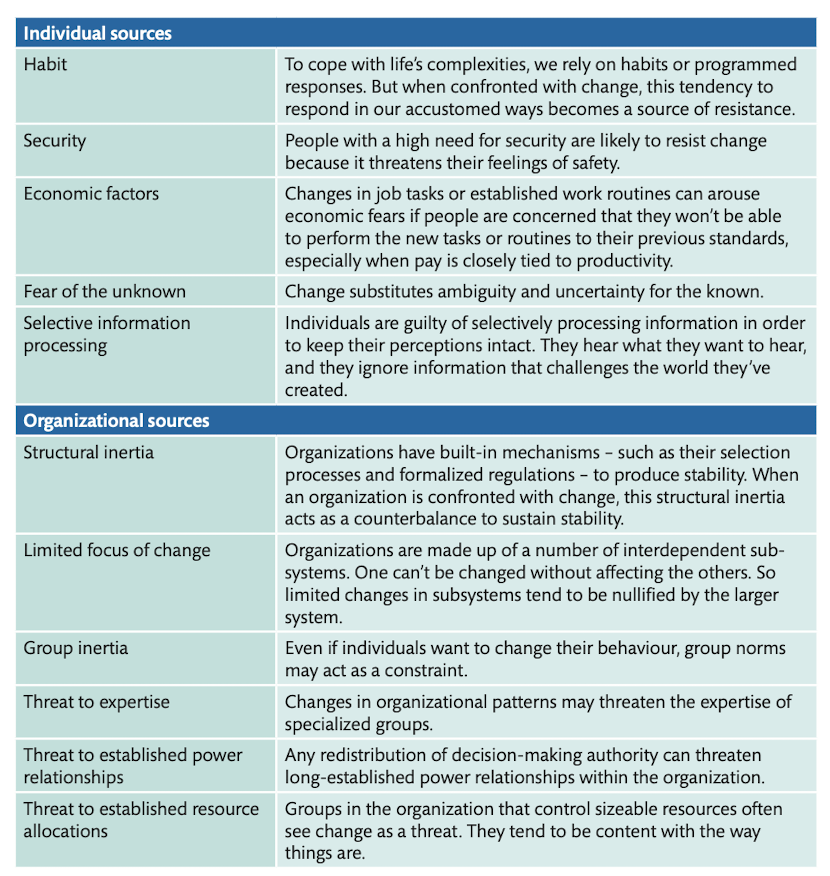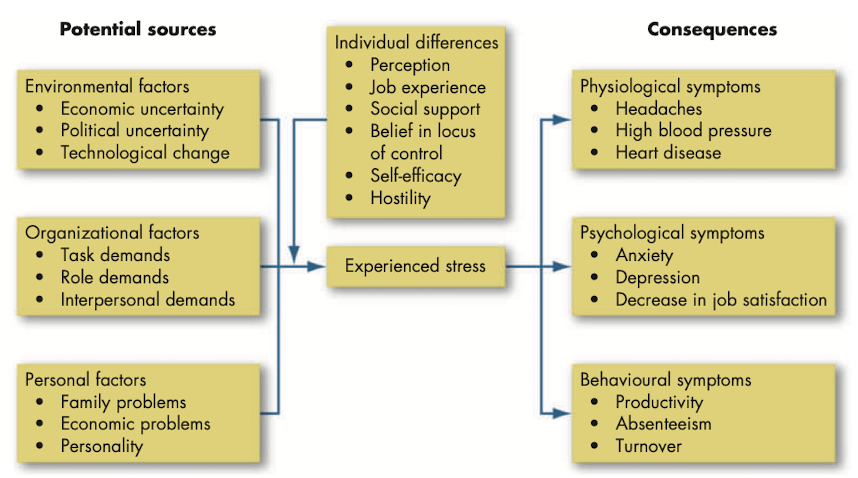
Chapter 18 - Organizational change & stress management
Forces for change

Planned change
Change: making things different.
Planned change: change activities that are intentional and goal-oriented.
Resistance to change
Change agents: persons who act as catalysts and assume the responsibility for managing change activities.

Approaches to managing organizational change
Lewin’s three-step model
Unfreezing: changing to overcome the pressures of both individual resistance and group conformity.
Movement: change process that transforms the organization from the status quo to a desired end state.
Refreezing: stabilizing a change intervention by balancing driving and restraining forces.
Driving forces: forces that direct behavior away from the status quo.
Restraining forces: forces that hinder movement from the existing equilibrium.
Kotter’s eight-step plan for implementing change
Establish a sense of urgency by creating a compelling reason for why change is needed.
Form a coalition with enough power to lead the change.
Create a new vision to direct the change and strategies for achieving the vision.
Communicate the vision throughout the organization.
Empower others to act on the vision by removing barriers to change and encouraging risk taking and creative problem solving.
Plan for, create and reward short-term “wins” that move the organization towards the new vision.
Consolidate improvements, reassess changes and make necessary adjustments in the new programs.
Reinforce the changes by demonstrating the relationship between new behaviors and organizational success.
Action research: change process based on systematic collection of data and then selection of a change action based on what the analyzed data indicate.
Organizational development (OD): collection of planned change interventions, built on humanistic democratic values, that seeks to improve organizational effectiveness and employee well-being.
Sensitivity training: training groups that seek to change behavior through unstructured group interaction.
Survey feedback: use of questionnaires to identify discrepancies among member perceptions; discussion follows and remedies are suggested.
Process consultation (PC): meeting in which a consultant assists a client in understanding process events with which he/she must deal and identifying processes that need improvement.
Team building: high interaction among team members to increase trust and openness.
Inter-group development: OD efforts to change the attitudes, stereotypes and perceptions that groups have of each other.
Appreciative inquiry (AI): approach that seeks to identify the unique qualities and special strengths of an organization, which can then be built on to improve performance.
Creating a culture for change
Stimulating a culture of innovation
Innovation: new idea applied to initiating or improving a product, process or service.
Idea champions: individuals who take an innovation and actively and enthusiastically promote the idea, build support, overcome resistance and ensure that the idea is implemented.
Creating a learning organization
Learning organization: organization that has developed the continuous capacity to adapt and change.
Single-loop learning: process of correcting errors using past routines and present policies.
Double-loop learning: process of correcting errors by modifying the organization’s objectives, policies and standard routines.
Work stress and its management
Stress: unpleasant psychological process that occurs in response to environmental pressures.
Challenge stressors: stressors associated with work load, pressure to complete tasks and time urgency.
Hindrance stressors: stressors that keep you from reaching your goals (red tape, office politics, confusion over job responsibilities).
Demands: responsibilities, pressures, obligations and even uncertainties that individuals face in the workplace.
Resources: things within an individual's control that can be used to resolve demands.

Chapter 18 - Organizational change & stress management
Forces for change

Planned change
Change: making things different.
Planned change: change activities that are intentional and goal-oriented.
Resistance to change
Change agents: persons who act as catalysts and assume the responsibility for managing change activities.

Approaches to managing organizational change
Lewin’s three-step model
Unfreezing: changing to overcome the pressures of both individual resistance and group conformity.
Movement: change process that transforms the organization from the status quo to a desired end state.
Refreezing: stabilizing a change intervention by balancing driving and restraining forces.
Driving forces: forces that direct behavior away from the status quo.
Restraining forces: forces that hinder movement from the existing equilibrium.
Kotter’s eight-step plan for implementing change
Establish a sense of urgency by creating a compelling reason for why change is needed.
Form a coalition with enough power to lead the change.
Create a new vision to direct the change and strategies for achieving the vision.
Communicate the vision throughout the organization.
Empower others to act on the vision by removing barriers to change and encouraging risk taking and creative problem solving.
Plan for, create and reward short-term “wins” that move the organization towards the new vision.
Consolidate improvements, reassess changes and make necessary adjustments in the new programs.
Reinforce the changes by demonstrating the relationship between new behaviors and organizational success.
Action research: change process based on systematic collection of data and then selection of a change action based on what the analyzed data indicate.
Organizational development (OD): collection of planned change interventions, built on humanistic democratic values, that seeks to improve organizational effectiveness and employee well-being.
Sensitivity training: training groups that seek to change behavior through unstructured group interaction.
Survey feedback: use of questionnaires to identify discrepancies among member perceptions; discussion follows and remedies are suggested.
Process consultation (PC): meeting in which a consultant assists a client in understanding process events with which he/she must deal and identifying processes that need improvement.
Team building: high interaction among team members to increase trust and openness.
Inter-group development: OD efforts to change the attitudes, stereotypes and perceptions that groups have of each other.
Appreciative inquiry (AI): approach that seeks to identify the unique qualities and special strengths of an organization, which can then be built on to improve performance.
Creating a culture for change
Stimulating a culture of innovation
Innovation: new idea applied to initiating or improving a product, process or service.
Idea champions: individuals who take an innovation and actively and enthusiastically promote the idea, build support, overcome resistance and ensure that the idea is implemented.
Creating a learning organization
Learning organization: organization that has developed the continuous capacity to adapt and change.
Single-loop learning: process of correcting errors using past routines and present policies.
Double-loop learning: process of correcting errors by modifying the organization’s objectives, policies and standard routines.
Work stress and its management
Stress: unpleasant psychological process that occurs in response to environmental pressures.
Challenge stressors: stressors associated with work load, pressure to complete tasks and time urgency.
Hindrance stressors: stressors that keep you from reaching your goals (red tape, office politics, confusion over job responsibilities).
Demands: responsibilities, pressures, obligations and even uncertainties that individuals face in the workplace.
Resources: things within an individual's control that can be used to resolve demands.

 Knowt
Knowt
